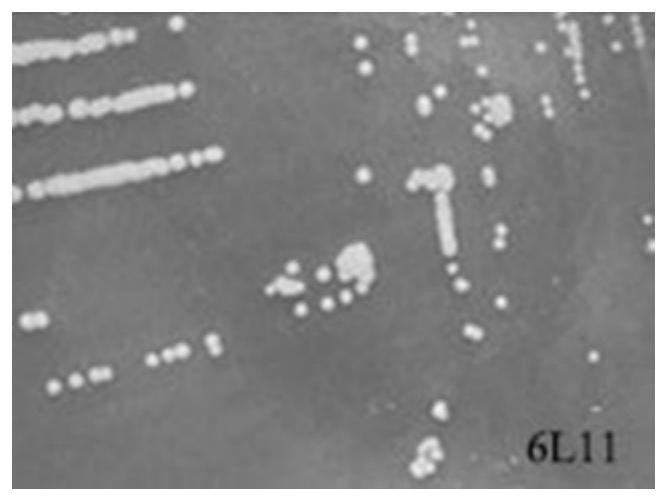A Lysing Pseudomonas Chlorite and Its Application
A technology of Pseudomonas and chlorous acid, applied in the field of microorganisms, can solve problems such as unreported Pseudomonas, and achieve the effects of enriching bacterial resources, promoting growth, and fast growth.
- Summary
- Abstract
- Description
- Claims
- Application Information
AI Technical Summary
Problems solved by technology
Method used
Image
Examples
Embodiment 1
[0055] Example 1: Strain identification
[0056] The present invention identifies a strain having a hydrochloric base having a salt-resistant base obtained by a screen selected, and identified by 16SRDNA and physiological and biochemical index, the strain is determined as a pseudomonaschloritidismutans. Among them, if figure 2 As shown, the colonies and bacteria characterized by Pseudomonaschloritidismutans 6L11: After culturing 24 h in Lb medium, the bacteria is circular, surface circular projections, smooth, humid, yellowish yellow , Marginal rules; bacteria is rod, Gram-negative, no spores. The physiological and biochemical characteristics of the strain are: contact enzyme positive, VP experiment negative, D-glucose positive, L-arabic sugar, D-mannool positive, hydrolyzed amylase positive, citrate utilization positive; the mirror detection effect of this colony Figure figure 1 Indicated.
[0057] The 16S rDNA sequence of Pseudomonas chloritidismut 6L11 is as follows:
[0058] C...
Embodiment 2
[0059] Example 2: Pseudomonas CHSeudomonaas Chloritidismutans 6L11 Greenhouse Promotional Test
[0060] The matrix of wheat seedlings into sterilization (salt base soil directly taken from Wudi County, Binzhou City, the soil pH is greater than 8.6, alkaline), after the wheat seeding, 1ml fermentation solution is diluted with water to 20 ml dilution, then Treatment of the amount of the fermentation liquid after 1 ml of wheat in potted plants. The control group was diluted with water to 20 mL for water, and then the wheat was treated. The control group ck.
[0061] After culturing 20D and 40D, measurement of wheat is measured, and the biomass, root development and chlorophyll content of potted wheat strains are detected, and the biomass, root development and chlorophyll content of the root part, and the results are shown in Table 1-3 and image 3 Indicated. As can be seen from the table: 6L11 can significantly promote the growth of wheat plants, for example, 20D and 40D wheat plant r...
Embodiment 3
[0070] Example 3: Test of 3 ligandulindozymes, pyrogen phosphorus, pitas and IAA
[0071]Detection of Pseudomonas chloritidismut 6L11 protease, pyrolysis, pitrifying capacity, product IAA and strain salt, alkali, and the results are 4-9 and Figure 4-7 Indicated.
[0072] Table 4 protease detection results
[0073]
[0074] Table 5 Polyophosphorus ability test results
[0075]
[0076] Table 6 strain production IAA content
[0077]
[0078] Table 7 Salt resistance test results
[0079]
[0080] Table 8 Substance of alkali resistance
[0081]
[0082] Table 9 Salt-resistant base resistance test results
[0083]
[0084] Note: In Table 8-10, the "+++" indicates that the growth is strong; ++ "indicates that the growth is better;" + "means growth;" - "means not growing
[0085] In summary, it can be seen that under potted conditions, the fermentation of the pseudocetransfills of the present invention can be treated after the seedling root of wheat, can produce proteases, gr...
PUM
 Login to View More
Login to View More Abstract
Description
Claims
Application Information
 Login to View More
Login to View More - R&D
- Intellectual Property
- Life Sciences
- Materials
- Tech Scout
- Unparalleled Data Quality
- Higher Quality Content
- 60% Fewer Hallucinations
Browse by: Latest US Patents, China's latest patents, Technical Efficacy Thesaurus, Application Domain, Technology Topic, Popular Technical Reports.
© 2025 PatSnap. All rights reserved.Legal|Privacy policy|Modern Slavery Act Transparency Statement|Sitemap|About US| Contact US: help@patsnap.com



